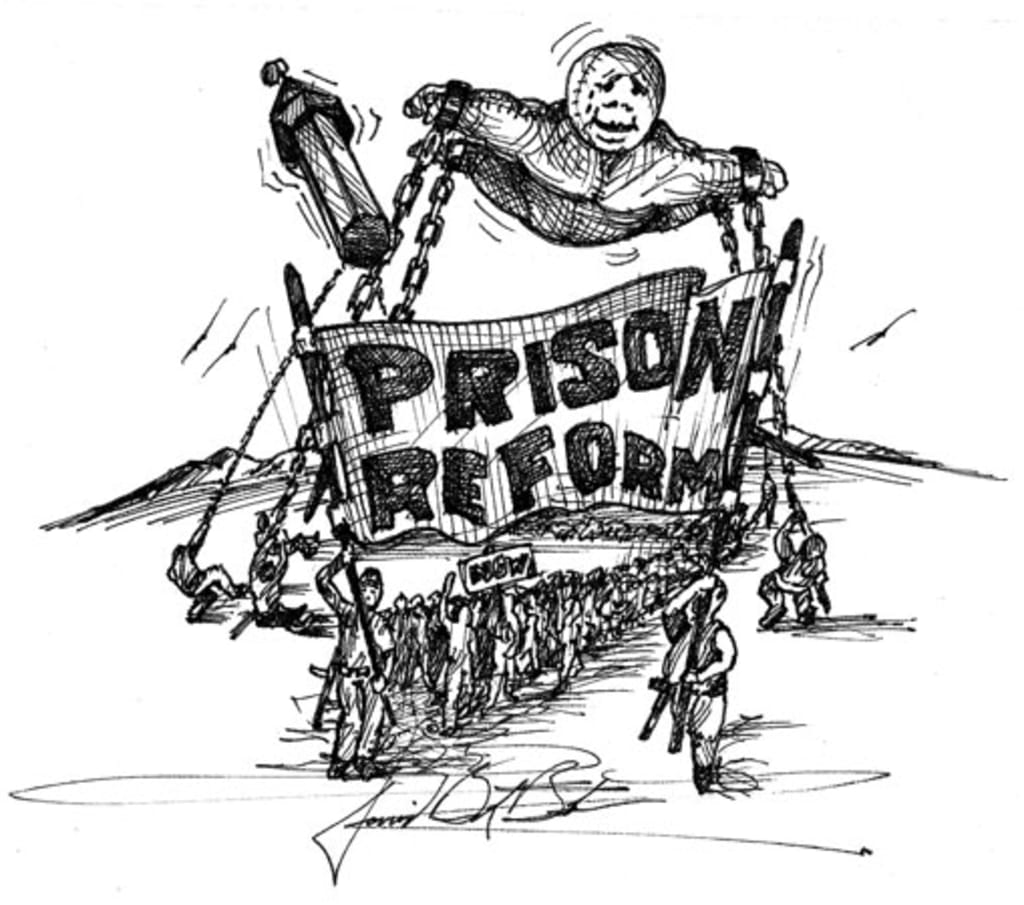On Prison Reform for US Prisons
Why is prison reform important?

Overcrowding has been one of the main issues in United States’s prison systems within both prisons and inmates alike. According to statistics gathered from the Bureau of Justice Statistics, the US actually comes in at number 13th as the world’s most overcrowded prisons (McCarthy, para. 1). The exceeding population in US prisons has threatened the deterioration of inmate’s and staff’s mental and physical well-being, as well as safety. The leading cause behind overcrowding in US prisons is due to the high rate of recidivism following criminals’ release. In order to prevent recidivism it is imperative that the US promotes prison reform, in which the prison system provides more resources and programs to better equip inmates with the skills to successfully integrate into American society.
If the United States is to resolve this issue, it is essential to get a clear idea of what recidivism is. Each incarcerated individual has a chance of either recidivating or desisting upon release. Recidivism is defined as the tendency for ex-convicts to commit crimes or reoffend, resulting in rearrest, reconviction, or a return to prison within three years of just having been released. On the other hand, the individual may choose not to recede. This action is referred to as disistance. In criminology, disistance is the term used for when former inmates come to a permanent state of non offending. When criminals reoffend, it is more often than not due to difficulty in returning to the community, which is why promoting prison reform is so important (National Institute of Justice, para. 1-5).
Statistics have proven the inefficiency of the US Prison System’s current methods. According to a variety of research conducted by the Bureau of Justice Statistics (BJS), since the 1980s, the rates of recidivism have been fairly high and stable throughout time. In their most recent study, “more than three-fourths of the nearly 70,000 prisoners released from 30 states in 2005 had been rearrested for a new offense within five years.” (Duwe, para. 10). Three-fourths of a population of released inmates is a relatively high number, for a system dedicated to the rehabilitation of criminals. Also, on “rehabilitation”, those inmates being released from prison are just unloaded into society with little to no skills for employment and are therefore subject to societal exclusion as well as poverty (The US Department of Justice Archives, para. 3). If the US prison system aims to restore an individual’s normal life after imprisonment, clearly the system has not been very efficient in doing so. Clearly, US prisons need to spend more time and energy looking for ways to improve the prison system through further reform. US Prisons would be far more successful if more programs directed at educating and providing more opportunities for inmates are included. By providing more of these programs, it will ensure that the inmates can do their time productively, instead of simply sitting around and going through the days before release. When serving their time, they can work towards an improved and less destructive lifestyle, so that when released back into the community, they are less likely to reoffend.
Prison reform statistics have shown that prison programming and expanding the prison workforce is an efficient way to reduce the high rates of recidivism. According to the US Department of Justice Archives, “inmates who worked in prison industries were 24 percent less likely to recidivate and 14 percent more likely to be gainfully employed after release from custody than other inmates” (US Department of Justice Archives, para. 5). If US prisons provide more jobs for inmates to work while incarcerated, they will be better equipped for employment outside of prison. An individual with a criminal record will most likely have more difficulty in finding jobs and furthermore, those who were not able to get a job in prison will not be able to meet the required experience or other qualifications for employment. By providing more jobs and opportunities for inmates in prison, the prison system is establishing a foundation for inmates, in which they are able to actually qualify for jobs outside of prison. Inmates who have been given more opportunities in prison may find it easier to successfully integrate back into the community after incarceration when they are made certain that there will be employers out there who can be convinced to take a chance on them.
More programs and resources should be made available for all incarcerated individuals in US Prisons. These programs and resources may include, but are not limited to, the harboring and development of inmates’ education, personal relationships, as well as their “criminogenic” needs. Providing an abundance of educational programs for inmates will definitely prove to be helpful in rehabilitation and release back into the community. In fact, an overlooked issue in the US Prison System is the high illiteracy rates among individuals in these prisons. The Literacy Project Foundation has discovered that a shocking amount of inmates within US prisons are plagued with illiteracy. Apparently, three out of five inmates in US prisons have little to no ability to read and 85 percent of juvenile delinquents have also expressed difficulty with reading. Proven by the San Francisco Chronicle, the high rates of recidivism is directly affected by rates of illiteracy in prison and that developing solid education in inmates is one of the most effective ways to prevent reincarceration (Sainato, para. 1).
On personal relationships, it is important for inmates to maintain relationships outside of prison so that a support system will be accessible to the inmate to aid in the process of returning to the community. However, healthy relationships with individuals in an inmate’s support system outside of prison are very hard to maintain with so limited contact during incarceration. Communication is the foundation of all healthy relationships. So, it is imperative that inmates have as much access to communication with the outside community as possible. Of course, the phone calls should still be monitored by prison authorities to ensure that there is no malicious intent behind a phone call. However, it is important that inmates are given more access to prison phones. Prison reform may find a resolution in possibly extending visitation rights and making sure that distance between family members, friends, and the inmate is taken into consideration when choosing prison placement for the inmate. While not perfect, this resolution will still be able to guarantee an improved connection with inmates and their outside support systems. Because the inmate has been locked away from the community for so long, it is possible that the community will have undergone many changes in the inmate’s absence. So, it will be much easier for the inmate to return to this less familiar community, knowing that there will be familiar faces inside that community ready to accept him or her with open arms.
Now, “criminogenic” needs, as referred to by the US Department of Justice Archives, include the characteristics, traits, behaviors, and issues that may be related to an individual’s probability to reoffend. It would be very beneficial for the prison system to identify and take into account these criminogenic needs, so that the inmate can have more access to resources to help in rehabilitation (US Department of Justice Archives, para. 1). For instance, an individual is incarcerated for selling or possessing illegal drugs. If thorough background search is performed on the individual, staff can be informed that the individual may have a history with drug abuse or addiction. This information would prove to be very helpful in rehabilitation. By focusing on the inmate’s criminogenic needs, the prison system can successfully obliterate any issues that may result in the inmate reoffending. With the ex-convict no longer having those issues that has previously led to the crime committed before incarceration, the ex-convict will most likely not commit that same crime or any other similar crime to get rearrested.
The US Prison System should take some lessons from the Norwegian methods of incarceration. Norway has the lowest recidivism rates in the world. Compared to the US recidivism rates, Norway only scratches the tip of the iceberg, with only a highest rate of 25 percent in recidivism. The main difference between the US Prison System and the Norwegian Prison System is that the US focuses more on punishment, while Norwegian prisons’ ultimate goal is to care and rehabilitate criminals. The US criminal justice system’s primary goal was rehabilitation, up until the twentieth century, when justifications were made and punishment became more dominant. The Quakers are a group of men who practiced pacifism and believed that all human beings are equal and should be treated equally, with the same respect as well. They played a big role in the US Justice System, forming the first prisons to ever exist in America. Originally, the Quakers had called them “penitentiaries”, rather than prisons, with the main purpose of rehabilitating criminals. They believed that all human beings have the ability to change, no matter how bad his or her crime was. For many years, following prisons have been built under the same model. However, during the late 1960s, the people decided that US prisons should focus more on punishment, with a majority of 52 percent of the public voting for punishment over rehabilitation. Now, the US has shown a preference for deterrence, incapacitation, and retribution as the main goals of punishment. However, the US has not emphasized any goal working towards rehabilitation and restorative justice, unlike the Norwegian Prison System. Norway has undoubtedly proven expertise in rehabilitating criminals and efficiency in their own methods. While the US is not exactly Norway, the US can become more like Norway, in that the US Prison System will become more efficient in successfully integrating inmates back into the community, without recidivism. The whole Norwegian Prison System is not the answer to resolve the issue of overcrowding and recidivism in US Prisons. However, perhaps taking notice that the Norwegian methods are very efficient in reducing recidivism rates and rehabilitation, the US can take some of the best Norwegian incarceration methods and incorporate it into the US Prison System’s methods(Labutta, para. 23-26).
Evidently, the main cause of recidivism is because the US has put too much emphasis on punishment, rather than rehabilitation. Therefore, upon release, ex-convicts are more likely to recidivate because incarceration has made it difficult to return to the community, as these individuals will return with a lack of education and skills to successfully integrate with other individuals of the respective community. Therefore, the US needs to promote further prison reform to help inmates return to their communities successfully and prevent them from reoffending. The US prisons system needs to turn the prisons into rehabilitation centers for public offenders, rather than a punishment center. It would be far more beneficial to utilize most of the inmates’ time in prison to teach them how to live a more successful life, without crime, than to waste all of the time the inmate has in prison on punishment alone. The latter would only continue to produce spiteful criminals who reoffend upon release. The US prison system should compare the methods and efficiency of the highly effective prison systems, like the Norwegian prison system mentioned in a previous paragraph. Seeing as rehabilitation happened to be very effective in their prisons, US Prisons should take notice and revise the system to support rehabilitation.
References
Duwe, G. (2017). Rethinking prison: a strategy for evidence-based reform. In AEI Paper & Studies (p. COVE+). Washington, DC: American Enterprise Institute. Retrieved from https://link-gale-com.ez1.maricopa.edu/apps/doc/A518801877/AONE?u=mcc_chandler&sid=AONE xid=52f6948e
Prison reform: reducing recidivism by strengthening the federal bureau of prisons. (2017, March 6). Retrieved from https://www.justice.gov/archives/prison-reform
Prison reform and alternatives to imprisonment. (n.d.). Retrieved from https://www.unodc.org/unodc/en/justice-and-prison-reform/prison-reform-and-alternatives-to-imprisonment.html
Nij. (n.d.). Recidivism. Retrieved from https://nij.ojp.gov/topics/corrections/recidivism
Labutta, E. (n.d.). The prisoner as one of us: norwegian wisdom for american penal practice: Emory University School of Law: Atlanta, GA. Retrieved from https://law.emory.edu/eilr/content/volume-31/issue-2/comments/prisoner-norwegian-wisdom-american-penal-practice.html
Sainato, M. (2017, July 18). US prison system plagued by high illiteracy rates. Retrieved from https://observer.com/2017/07/prison-illiteracy-criminal-justice-reform/
McCarthy, N., & Richter, F. (2018, January 30). Infographic: the world's most overcrowded prison systems. Retrieved May 19, 2020, from https://www.statista.com/chart/12717/the-worlds-most-overcrowded-prison-systems/
About the Creator
Salem Rosé
I love writing ✍️






Comments
There are no comments for this story
Be the first to respond and start the conversation.